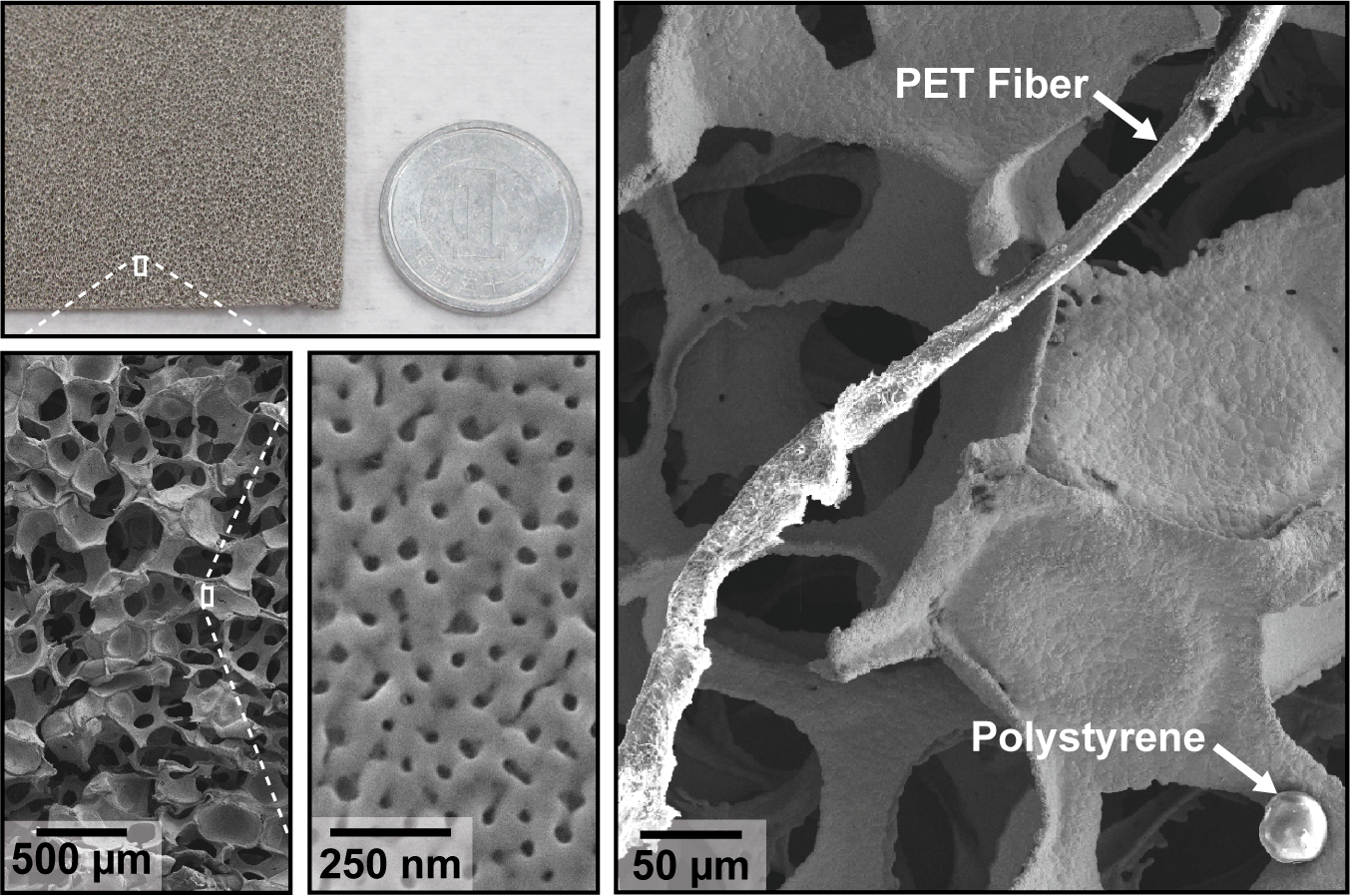Researchers at Nagoya University, in collaboration with the National Institute for Materials Sciences (NIMS) in Japan and others, have developed a method to readily detect microplastics in marine and freshwater environments using inexpensive porous metal substrates. This method, utilizing optical analysis and machine learning techniques, is detailed in the journal Nature Communications.
 Upper left: Metal foam and a 1-yen coin for scale. Bottom left: SEM image of a silver foam showing macropores used to capture microplastics from solution. Bottom middle: SEM image of the nanoscale pores used to capture light and enhance the chemical signal of the microplastics. Right: SEM image of the metal foam exposed to polystyrene beads, PET fibers, algae, and soil. Image Credit: Olga Guselnikova and Joel Henzie.
Upper left: Metal foam and a 1-yen coin for scale. Bottom left: SEM image of a silver foam showing macropores used to capture microplastics from solution. Bottom middle: SEM image of the nanoscale pores used to capture light and enhance the chemical signal of the microplastics. Right: SEM image of the metal foam exposed to polystyrene beads, PET fibers, algae, and soil. Image Credit: Olga Guselnikova and Joel Henzie.
Detecting and identifying microplastics in water samples is crucial for environmental monitoring, yet it poses challenges, partly because of the structural resemblance between microplastics and natural organic compounds originating from biofilms, algae, and decaying organic matter. Current detection methods often necessitate intricate separation techniques, which are time-consuming and expensive.
Our new method can simultaneously separate and measure the abundance of six key types of microplastics - polystyrene, polyethylene, polymethylmethacrylate, polytetrafluoroethylene, nylon and polyethylene terephthalate.
Dr. Olga Guselnikova, National Institute for Materials Science
The system employs a porous metal foam to capture microplastics from the solution and detect them optically through surface-enhanced Raman spectroscopy (SERS).
“The SERS data obtained is highly complex, but it contains discernible patterns that can be interpreted using modern machine learning techniques,” notes Dr. Joel Henzie of NIMS.
The team developed a neural network computer algorithm named SpecATNet for data analysis. This algorithm is trained to decipher the patterns in optical measurements, enabling quicker and more accurate identification of the target microplastics than traditional methods.
Our procedure holds immense potential for monitoring microplastics in samples obtained directly from the environment, with no pretreatment required, while being unaffected by possible contaminants that could interfere with other methods.
Yusuke Yamauchi, Professor, Nagoya University
The researchers aim for their innovation to significantly aid society in assessing the impact of microplastic pollution on public health and the health of organisms in marine and freshwater environments. By developing affordable microplastic sensors and open-source algorithms for data interpretation, they aspire to facilitate the swift detection of microplastics, even in labs with limited resources.
The materials needed for the new system offer cost savings ranging from 90 to 95% compared to commercially available alternatives. The team aims to further reduce the cost of these sensors and streamline the methods for easy replication without requiring expensive facilities.
Additionally, the researchers aspire to enhance the SpecATNet neural network's capacity to detect a wider range of microplastics and accommodate various spectroscopic data types beyond SERS data.
Journal Reference:
Guselnikova, O., et al. (2024). Pretreatment-free SERS sensing of microplastics using a self-attention-based neural network on hierarchically porous Ag foams. Nature Communications. doi.org/10.1038/s41467-024-48148-w.